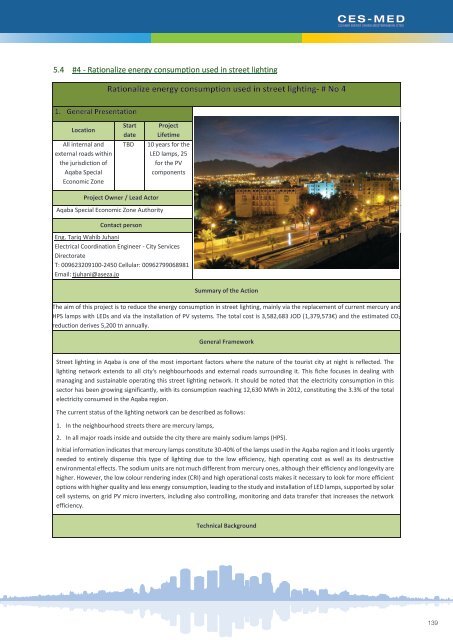161117_Jordan_ASEZA_SECAP_Revised
Create successful ePaper yourself
Turn your PDF publications into a flip-book with our unique Google optimized e-Paper software.
5.2 #2 - Smarter Transportation System (STS)<br />
1. General Presentation<br />
Location<br />
Aqaba Special<br />
Economic<br />
Zone<br />
Authority –<br />
Aqaba City,<br />
<strong>Jordan</strong><br />
Start<br />
date<br />
TBD<br />
Smarter Transportation System (STS)- # No 2<br />
Project Lifetime<br />
24 months<br />
(implementation)<br />
Project Owner / Lead Actor<br />
Aqaba Special Economic Zone Authority<br />
Contact person<br />
Saed Al Masoud<br />
Technical Expert<br />
Aqaba City affairs Commission<br />
smasoud@aseza.jo<br />
Summary of the Action<br />
This project envisages the effective management of the Transport Sector, the replacement of specific vehicles in the municipal<br />
fleet with new, more efficient ones, as well as the use of incentives (legislative or other) to promote clean vehicles’ use in the<br />
private transport (mainly taxis) and the use of RES technologies in public transport (buses). The total cost is 185,489JOD<br />
(242,990€). The CO2 reduction from the actions in all sectors is more than 10,600 tn.<br />
General Framework<br />
Our approach to Smart Transportation system (STS) begins with creating a strategic transportation vision, identifying and<br />
communicating with key stake holders, and aligning with the overarching goals of the <strong>ASEZA</strong>. <strong>ASEZA</strong> will take the responsibility<br />
not only to implement the actions for energy reduction in the municipal fleet but it will also coordinate the proposed actions<br />
in the public and private sector and support respectively the citizens. All the energy savings and CO2 reductions-except from<br />
this for the municipal fleet- will be realized if the inhabitants decide to implement the proposed measures. Therefore in section<br />
6, two different numbers for each estimation are provided. Smart Transportation strategic approach will address 4 key<br />
imperatives in parallel:<br />
1- Predict demand and optimize capacity, assets and infrastructure. Current transportation systems experience both<br />
congestion and under-utilization because demand is not accurately predicted, capacity is poorly managed and loads are<br />
not balanced. This wastes money and time and degrades the quality of the provided service. Transportation providers<br />
need deeper insights and predictive models for demand throughout the network. Some are already collecting and<br />
analysing historic and real-time data from digital devices to see patterns based on recurring factors such as location, time<br />
and date, as well as unplanned factors such as weather. The sources of this information include sensors on vehicles and<br />
infrastructure, video monitoring, GPS data, mobile phone signals, satellite images, traffic control data, reservation<br />
systems, smart fare cards and more.<br />
2- Improve the end-to-end experience for travellers and freight customers. In a smarter transportation system, travellers<br />
and freight customers are empowered with information and tools to determine themselves the best way to move from<br />
origin to destination, throughout all transportation modes, with due consideration to cost, time, convenience and<br />
environmental impact.<br />
3- Increase operational efficiency while reducing environmental impact. The inefficiencies of today’s transportation systems<br />
can translate into deteriorating service, excess cost, energy use and environmental impact. In urban areas we are reaching<br />
the limits of how much land can be dedicated to new roads, rails and terminals. Transportation systems are tremendously<br />
124

















